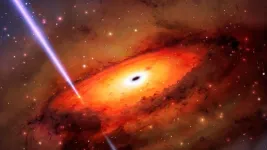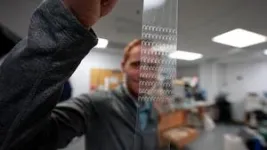(Press-News.org) Most stars in the Universe die in predictable ways, depending on their mass. Relatively low-mass stars like our Sun slough off their outer layers in old age and eventually fade to become white dwarf stars. More massive stars burn brighter and die sooner in cataclysmic supernova explosions, creating ultradense objects like neutron stars and black holes. If two such stellar remnants form a binary system, they also can eventually collide. New research, however, points to a long-hypothesized, but never-before-seen, fourth option.
While searching for the origins of a long-duration gamma-ray burst (GRB), astronomers using the Gemini South telescope in Chile, part of the International Gemini Observatory operated by NSF’s NOIRLab, and other telescopes [1], have uncovered evidence of a demolition-derby-like collision of stars or stellar remnants in the chaotic and densely packed region near an ancient galaxy’s supermassive black hole.
“These new results show that stars can meet their demise in some of the densest regions of the Universe where they can be driven to collide,” said Andrew Levan, an astronomer with Radboud University in The Netherlands and lead author of a paper appearing in the journal Nature Astronomy. “This is exciting for understanding how stars die and for answering other questions, such as what unexpected sources might create gravitational waves that we could detect on Earth.”
Ancient galaxies are long past their star-forming prime and would have few, if any, remaining giant stars, the principal source of long GRBs. Their cores, however, are teeming with stars and a menagerie of ultra-dense stellar remnants, such as white dwarf stars, neutron stars, and black holes. Astronomers have long suspected that in the turbulent beehive of activity surrounding a supermassive black hole, it would only be a matter of time until two stellar objects collide to produce a GRB. Evidence for that type of merger, however, has been elusive.
The first hints that such an event had occurred were seen on 19 October 2019 when NASA’s Neil Gehrels Swift Observatory detected a bright flash of gamma rays that lasted for a little more than one minute. Any GRB lasting more than two seconds is considered “long.” Such bursts typically come from the supernova death of stars at least 10 times the mass of our Sun — but not always.
The researchers then used Gemini South to make long-term observations of the GRB’s fading afterglow to learn more about its origins. The observations allowed the astronomers to pinpoint the location of the GRB to a region less than 100 light-years from the nucleus of an ancient galaxy, which placed it very near the galaxy’s supermassive black hole. The researchers also found no evidence of a corresponding supernova, which would leave its imprint on the light studied by Gemini South.
“Our follow-up observation told us that rather than being a massive star collapsing, the burst was most likely caused by the merger of two compact objects,” said Levan. “By pinpointing its location to the center of a previously identified ancient galaxy, we had the first tantalizing evidence of a new pathway for stars to meet their demise.”
In normal galactic environments, the production of long GRBs from colliding stellar remnants such as neutron stars and black holes is thought to be vanishingly rare. The cores of ancient galaxies, however, are anything but normal and there may be a million or more stars crammed into a region just a few light-years across. Such extreme population density may be great enough that occasional stellar collisions can occur, especially under the titanic gravitational influence of a supermassive black hole, which would perturb the motions of stars and send them careening in random directions. Eventually, these wayward stars would intersect and merge, triggering a titanic explosion that could be observed from vast cosmic distances.
It is possible that such events occur routinely in similarly crowded regions across the Universe but have gone unnoticed until this point. A possible reason for their obscurity is that galactic centers are brimming with dust and gas, which could obscure both the initial flash of the GRB and the resulting afterglow. This particular GRB, identified as GRB 191019A, may be a rare exception, allowing astronomers to detect the burst and study its after effects.
The researchers would like to discover more of these events. Their hope is to match a GRB detection with a corresponding gravitational-wave detection, which would reveal more about their true nature and confirm their origins, even in the murkiest of environments. The Vera C. Rubin Observatory, when it comes online in 2025, will be invaluable in this kind of research.
“Studying gamma-ray bursts like these is a great example of how the field is really advanced by many facilities working together, from the detection of the GRB, to the discoveries of afterglows and distances with telescopes like Gemini, through to detailed dissection of events with observations across the electromagnetic spectrum,” said Levan.
“These observations add to Gemini’s rich heritage developing our understanding of stellar evolution,” says Martin Still, NSF’s program director for the International Gemini Observatory. “The time sensitive observations are a testament to Gemini’s nimble operations and sensitivity to distant, dynamic events across the Universe.”
More information
Reference: Levan, A. J., Malesani, D. B., Gompertz, B. P., et al. (2023) “A long-duration gamma-ray burst of dynamical origin from the nucleus of an ancient galaxy.” Nature Astronomy. DOI: 10.1038/s41550-023-01998-8
[1] Additional observations were made with the Nordic Optical Telescope and the NASA/ESA Hubble Space Telescope.
NSF’s NOIRLab, the US center for ground-based optical-infrared astronomy, operates the International Gemini Observatory (a facility of NSF, NRC–Canada, ANID–Chile, MCTIC–Brazil, MINCyT–Argentina, and KASI–Republic of Korea), Kitt Peak National Observatory (KPNO), Cerro Tololo Inter-American Observatory (CTIO), the Community Science and Data Center (CSDC), and Vera C. Rubin Observatory (operated in cooperation with the Department of Energy’s SLAC National Accelerator Laboratory). It is managed by the Association of Universities for Research in Astronomy (AURA) under a cooperative agreement with NSF and is headquartered in Tucson, Arizona. The astronomical community is honored to have the opportunity to conduct astronomical research on Iolkam Du’ag (Kitt Peak) in Arizona, on Maunakea in Hawai‘i, and on Cerro Tololo and Cerro Pachón in Chile. We recognize and acknowledge the very significant cultural role and reverence that these sites have to the Tohono O’odham Nation, to the Native Hawaiian community, and to the local communities in Chile, respectively.
Links
Research paper
Photos of Gemini South
Videos of Gemini South END
Never-before-seen way to annihilate a star
International Gemini Observatory traces gamma-ray burst to nucleus of ancient galaxy, suggesting stars can undergo demolition-derby-like collisions
2023-06-22
ELSE PRESS RELEASES FROM THIS DATE:
Stellar demolition derby births powerful gamma-ray burst
2023-06-22
While searching for the origins of a powerful gamma-ray burst (GRB), an international team of astrophysicists may have stumbled upon a new way to destroy a star.
Although most GRBs originate from exploding massive stars or neutron-star mergers, the researchers concluded that GRB 191019A instead came from the collision of stars or stellar remnants in the jam-packed environment surrounding a supermassive black hole at the core of an ancient galaxy. The demolition derby-like environment points to a ...
Einstein and Euler put to the test at the edge of the Universe
2023-06-22
The cosmos is a unique laboratory for testing the laws of physics, in particular those of Euler and Einstein. Euler described the movements of celestial objects, while Einstein described the way in which celestial objects distort the Universe. Since the discovery of dark matter and the acceleration of the Universe’s expansion, the validity of their equations has been put to the test: are they capable of explaining these mysterious phenomena? A team from the University of Geneva (UNIGE) has developed the first method to find out. It ...
Promoting high energy Na4MnCr(PO4)3 capable of three-electron reaction for SSSMBs
2023-06-22
They published their work on June. 9 in Energy Material Advances.
"The development of high safety and high energy density SIBs is imperative," said paper author Zhongyue Wang, lecture with the College of electronic and optical engineering & college of flexible electronics (future technology), Nanjing University of Posts and Telecommunications. "Currently, great progress has been made in sodium-ion batteries, but their energy density is still much lower than LIBs limited by the cathode."
Wang explained that NASICON-type phosphate (NaxMM’(PO4)3, M, M' =transition metal Ti, V, Cr, Mn, Fe, Co and Ni) is regarded ...
Statewide study explores how pre-existing disease has influenced the COVID-19 experience
2023-06-22
INDIANAPOLIS - A study of more than three-quarters of a million Indiana COVID-19 cases is one of the first to focus on the disease in the Midwest. The research examines the relationship between the presence of pre-existing disease and COVID-19 outcomes in a region that has some of the highest prevalence of comorbidities, including hypertension, chronic obstructive pulmonary disease (COPD) and diabetes.
The study, conducted by researchers from Regenstrief Institute, Indiana University and The Ohio State University sourced data through the COVID-19 Research Data Commons. For COVID-19 patients, research demonstrated the pre-existing ...
AI could transform the way we understand emotion
2023-06-22
An emotion recognition tool - developed by University of the West of Scotland (UWS) academics - could help people with neurodiverse conditions including autism.
Traditionally, emotion recognition has been a challenging and complex area of study. However, with recent advancements in vision processing, and low-cost devices, such as wearable electroencephalogram (EEG) and electrocardiogram (ECG) sensors, UWS academics have collaborated to harness the power of these technologies to create artificial intelligence (AI) which can accurately read emotion-related signals from brain and facial analysis.
Professor Naeem Ramzan, ...
More positive outcomes when elderly are treated locally
2023-06-22
Older people with health problems often need some form of intermediate level monitoring, care and treatment services.
They may not need the resources of a hospital but do require somewhat more advanced help than a nursing home can usually offer. "Intermediate care units" are primarily intended to replace an acute hospital admission, but are occasionally also used following admission.
“Intermediate care units are the newest trend in health policy, and Norway is way ahead of the curve in this regard,” says Pål Erling Martinussen, a professor in the Department of Sociology and Political ...
The ACMG Releases 2023 Update to Secondary Findings Gene List; SF v3.2
2023-06-22
The American College of Medical Genetics and Genomics (ACMG) has released its highly anticipated 2023 update to the recommended minimum gene list for the reporting of secondary findings (SF): “ACMG SF v3.2 List for Reporting of Secondary Findings in Clinical Exome and Genome Sequencing: A Policy Statement of the American College of Medical Genetics and Genomics (ACMG).” In 2021, the ACMG Board of Directors and Secondary Findings Working Group (SFWG) stated that the College would update the list annually. Today’s update (SF v3.2) is being published in ACMG’s flagship journal, Genetics ...
Lupus Research Alliance honors Carola Vinuesa, MD, PhD, for discovering a specific gene variant that causes lupus in some patients
2023-06-22
NEW YORK, NY – June 22, 2023 – The Lupus Research Alliance awarded its 2023 Lupus Insight Prize to Carola Vinuesa, MD, PhD, of The Francis Crick Institute, for her seminal discovery that a mutation in a specific human gene causes systemic lupus erythematosus (SLE), uncovering an important target for the development of novel treatment. The Lupus Insight Prize is awarded each year to an outstanding investigator who has made a significant discovery that will advance our understanding of the pathogenesis, diagnosis, or treatment of lupus.
Dr. Vinuesa ...
Portable tool to diagnose and monitor sickle cell disease receives U.S. patent
2023-06-22
In the United States, sickle cell disease affects about 100,000 people and about 2 million Americans carry this genetic mutation. The most common and serious problems caused by sickle cell disease are anemia, pain and organ failure – stroke affects about 10 out of 100 children who have this disease. The national median life expectancy for people who have sickle cell disease can reach up to age 50.
This inherited, lifelong blood disorder is characterized by rigid and sickle-shaped red blood cells due to a dramatic change in their morphology. They stick to blood vessels, blocking ...
Model blood-brain barrier could improve newborn meningitis treatment
2023-06-22
Washington, D.C. – Investigators in Israel and Italy have developed a model of the blood-brain barrier, studies of which may lead to prevention of meningitis in newborns. The research is published in Microbiology Spectrum, a journal of the American Society for Microbiology.
The investigators further developed a platform called organs-on-a-chip—invented during the 2000s—to construct the model. These devices, which are modeled after microchips, contain tiny channels lined with living human ...
LAST 30 PRESS RELEASES:
Scientists boost cell "powerhouses" to burn more calories
Automatic label checking: The missing step in making reliable medical AI
Low daily alcohol intake linked to 50% heightened mouth cancer risk in India
American Meteorological Society announces Rick Spinrad as 2026 President-Elect
Biomass-based carbon capture spotlighted in newly released global climate webinar recording
Illuminating invisible nano pollutants: advanced bioimaging tracks the full journey of emerging nanoscale contaminants in living systems
How does age affect recovery from spinal cord injury?
Novel AI tool offers prognosis for patients with head and neck cancer
Fathers’ microplastic exposure tied to their children’s metabolic problems
Research validates laboratory model for studying high-grade serous ovarian cancer
SIR 2026 delivers transformative breakthroughs in minimally invasive medicine to improve patient care
Stem Cell Reports most downloaded papers of 2025 highlight the breadth and impact of stem cell research
Oxford-led study estimates NHS spends around 3% of its primary and secondary care budget on the health impacts of heat and cold in England
A researcher’s long quest leads to a smart composite breakthrough
Urban wild bees act as “microbial sensors” of city health.
New study finds where you live affects recovery after a hip fracture
Forecasting the impact of fully automated vehicle adoption on US road traffic injuries
Alcohol-related hospitalizations from 2016 to 2022
Semaglutide and hospitalizations in patients with obesity and established cardiovascular disease
Researchers ‘listen in’ to embryo-mother interactions during implantation using a culture system replicating the womb lining
How changing your diet could help save the world
How to make AI truly scalable and reliable for real-time traffic assignment?
Beyond fragmented markets: A new framework for efficient and stable ride-pooling
Can shape priors make road perception more reliable for autonomous driving?
AI tracks nearly 100 years of aging research, revealing key trends and gaps
Innovative techniques enable Italy’s first imaging of individual trapped atoms
KIER successfully develops Korea-made “calibration thermoelectric module” for measuring thermoelectric device performance
Diversifying US Midwest farming for stability and resilience
Emphasizing immigrants’ deservingness shifts attitudes
Japanese eels, climate change, and river temperature
[Press-News.org] Never-before-seen way to annihilate a starInternational Gemini Observatory traces gamma-ray burst to nucleus of ancient galaxy, suggesting stars can undergo demolition-derby-like collisions






